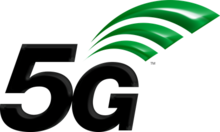
Back جيل خامس (شبكات اتصال) Arabic 5G Azerbaijani 5G Byelorussian 5G Bulgarian 5जी Bihari ৫জি Bengali/Bangla 5G Tibetan 5G BS 5G Catalan 5G Czech
 3GPP's 5G logo | |
| Developed by | 3GPP |
|---|---|
| Introduced | July 2016 |
| Industry | Telecommunications |
| Superseded by | 6G |
| Part of a series on the |
| Wireless network technologies |
|---|
 |
| Analog |
| Digital |
| Mobile telecommunications |


In telecommunications, 5G is the fifth generation of cellular network technology, which mobile operators began deploying worldwide in 2019 as the successor to 4G. 5G is based on standards defined by the International Telecommunication Union (ITU) under the IMT-2020 requirements, which outline performance targets for speed, latency, and connectivity to support advanced use cases.
Like their predecessors, 5G networks are cellular networks, in which the service area is divided into small geographical areas called cells. All 5G wireless devices in a cell are connected to the Internet and the telephone network by radio waves through a base station and antennae in the cell. The new networks offer not only higher download speeds, with a peak speed of 10 gigabits per second (Gbit/s) when there is only one user in the network, but also significantly lower latency, enabling near-instantaneous communication.[1] 5G networks have higher bandwidth, allowing them to connect more devices simultaneously and improving the quality of Internet services in crowded areas.[2] These features make 5G particularly suited for applications requiring real-time data exchange, such as extended reality (XR), autonomous vehicles, remote surgery, and industrial automation. Additionally, the increased bandwidth is expected to drive the adoption of 5G as a general Internet service provider (ISP), particularly through fixed wireless access (FWA), competing with existing technologies such as cable Internet, while also facilitating new applications in the Internet of Things (IoT) and machine-to-machine communication.
The increased bandwidth and lower latency of 5G networks enable highly responsive, large-scale IoT deployments, supporting diverse applications such as smart cities, connected infrastructure, industrial IoT, and automated manufacturing processes. Unlike 4G, which was primarily designed for mobile broadband, 5G can handle millions of IoT devices with stringent performance requirements, such as real-time sensor data processing and edge computing.
5G networks also extend beyond terrestrial infrastructure, incorporating non-terrestrial networks (NTN) such as satellites and high-altitude platforms, to provide global coverage, including remote and underserved areas.
Despite its performance improvements, 5G deployment faces challenges such as significant infrastructure investment, spectrum allocation, security risks, and concerns about energy efficiency and environmental impact associated with the use of higher frequency bands. However, it is expected to drive advancements in sectors like healthcare, transportation, and entertainment.
Devices with 4G capabilities are not compatible with 5G networks due to the lack of necessary hardware to support the significant changes in network architecture and the higher frequencies used in 5G.
- ^ Hoffman, Chris (January 7, 2019). "What is 5G, and how fast will it be?". How-To Geek website. How-To Geek LLC. Archived from the original on January 24, 2019. Retrieved January 23, 2019.
- ^ "5G explained: What it is, who has 5G, and how much faster is it really?". www.cnn.com. Archived from the original on November 27, 2021. Retrieved November 27, 2021.